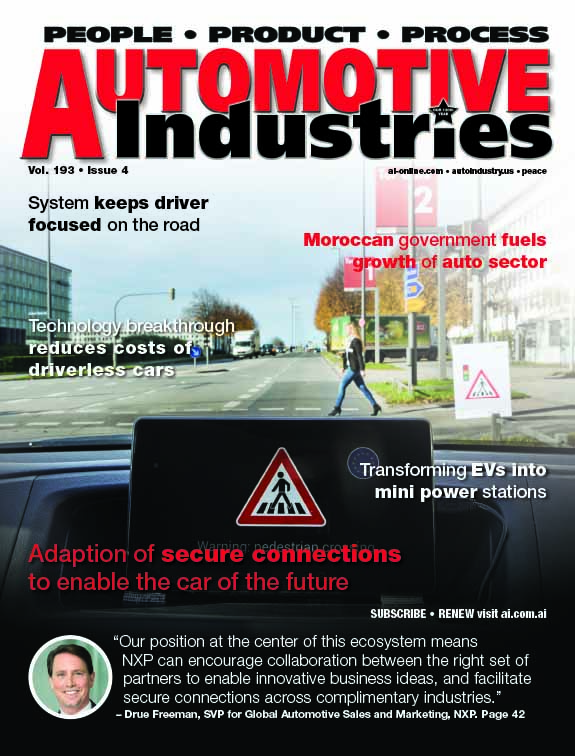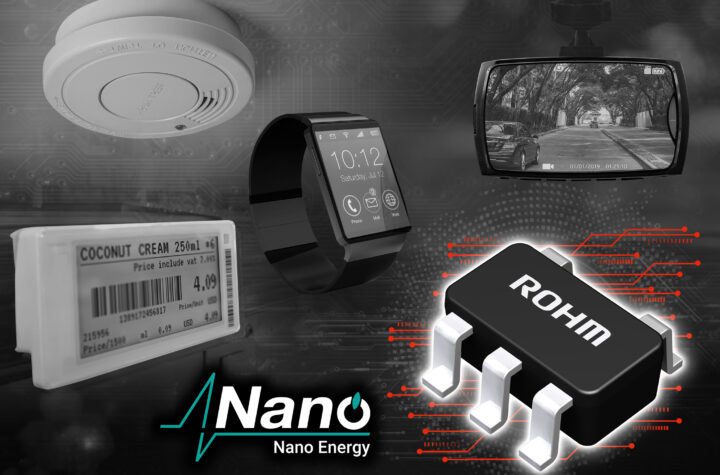Services like car sharing, corporate fleet management, Bluetooth and Wi-Fi pairing, together with the demand for personalization inside the car are driving a rapid growth in the automotive NFC (Near Field Communication) market.
Automotive NFC can connect vehicles and car keys to portable devices and infrastructure, opening up the possibility for a broad range of connectivity innovations, for example, payment services or connected displays. Use of the technology is expected to accelerate with the announcement by NXP Semiconductors that it has launched a complete portfolio of automotive-qualified NFC products. The Dutch company will enable drivers and passengers to securely connect to the quickly growing NFC ecosystem. The new product line-up ranges from NFC tags and transceivers to the new flagship, high-end NFC controller, the NCF3340.
Automotive Industries (AI) asked Drue Freeman, SVP for Global Automotive Sales and Marketing, NXP, how their new NFC products will help further the connectivity between cars and smartphones.
Freeman: As co-inventor of NFC technology we were one of the first companies to recognize the vast potential of NFC to provide secure connections across a variety of different market sectors. In the automotive sector NFC can bring a range of intuitive and convenient features to the car. These can be as simple as using your smartphone to open a car door – ideal for fleets, car sharing, or rental car applications. Or they can be complex, such as personalization, whereby drivers can load personal preferences such as their seat position, favorite radio station and preferred car temperature into their phone. They load their preferences simply by touching their phone against a controller.
AI: How will NXP’s NFC solutions help automakers reduce time to market?
Freeman: Working with our partners, we can help auto makers accelerate time to market in two main ways. The first is with products that are specifically designed with the automotive industry in mind from concept to creation. All our automotive products are designed by our automotive experts, allowing car manufacturers to benefit from our extensive experience to speed up their own design innovations. The second is through our extensive partner network in the NFC ecosystem. Our partnerships extend far beyond smartphones into areas such as smartcards, mobility providers, fleet management, payments and e-Government – all of which can bring fresh innovation and new ideas to the automotive industry. Our position at the center of this ecosystem means NXP can encourage collaboration between the right set of partners to enable innovative business ideas and facilitate secure connections across complimentary industries.
AI: What are some of the ways that V2X technology can help make driving safer?
Freeman: A study by the US Department of Transportation found that the safety benefits of V2X (Vehicle to Vehicle and Vehicle to Infrastructure) applications could prevent as many as 592,000 crashes and save 1,083 lives per year once the entire U.S. vehicle fleet has the technology. V2X technology allows cars to communicate with each other and the surrounding intelligent traffic infrastructure over a wireless networking standard tailored to the automotive industry (IEEE 802.11p). Drivers can securely receive real-time warnings of potential collisions, even in non-line-of-sight situations such as blind intersections. Because the technology is based on Wi-Fi rather than often unreliable cellular networks, the direct V2X communication ensures road users receive instant and secure transmission of traffic and vehicle data over long distances. The technology therefore ideally complements existing driver assistance systems such as cameras or radar.
AI: Tell us about NXP’s role in the Intelligent Transport System’s project in Europe?
Freeman: In 2013, transport ministers from Germany, Austria and the Netherlands announced they would be creating a crossborder corridor to demonstrate the benefits of intelligent traffic infrastructure from environmental, financial and safety points of view. The initiative requires a strong collaboration across ministries, motorway operators and the automotive industry to prepare the corridor for public use in 2015. NXP initiated a test drive along the corridor last year, bringing on board technology partners that are also committed to improving road safety – such as Siemens and Honda. The tour involved a small fleet of Honda vehicles fitted with NXP / Cohda Wireless RoadLINK V2X technology driving through 1,300km of roads across the three countries. This included ITS test fields in Munich, Vienna and Helmond fitted with Siemens intelligent traffic infrastructure. The demonstration showed how the new technology could dramatically reduce the number of fatalities on European roads by alerting drivers to upcoming road works, oncoming emergency vehicles, pending speed limits and braking of vehicles ahead. The ITS Corridor also highlighted how cars will be able to communicate with intelligent traffic lights to reduce congestions and minimize environmental damage and economic loss caused by traffic jams, estimated to have cost Europe approximately €7.4 billion in 2013.
AI: How do you see such programs being replicated in other parts of the globe?
Freeman: The potential for this technology to dramatically improve safety, as well as provide significant financial savings, will see it given a high priority by automotive manufacturers and governments around the world. AI asked Lars Reger, VP R&D and new business, NXP Automotive what makes NXP’s automotive NFC products game-changers. Reger: NXP’s extensive experience in working with smartphone manufacturers to develop NFCenabled devices coupled with our deep knowledge of automotive requirements puts us in a unique position to deliver solutions that can help the automotive industry bring its own technologies to market quickly and securely.
AI: What is your prediction for the future of connected cars and driverless cars?
Reger: Ultimately, our technologies are transforming vehicles into super computers on wheels, housing huge amounts of data to enable safer, more efficient and convenient driving. In so doing we’re also opening cars up to the same security threats facing other connected devices like smartphones, including hacking and viruses. Overcoming security obstacles will be critical to the success of connected vehicles and will require a raft of lock-tight security measures. The good news is that these security measures don’t need to be created from scratch.
The automotive industry can leverage high-level security technology that already exists in mission-critical industries such as banking. By introducing existing “bank level” security – similar to what we see today in ATM cards, digital IDs and passports – into the car, malicious elements can be blocked and vital systems protected.
AI: What protection is built into your systems?
Reger: In terms of solutions protecting cars against hacking, NXP provides specialized computer chips that can send, receive and store data, and operate software. The chips include cryptographic co-processors, a secure memory, and a random number generator. These secure elements have been optimized for use in the extreme conditions on the road – they work perfectly in extreme temperatures so they can cope in any climate from Finnish winter to the height of summer. One example of automotive security chips is the NXP P60 family. In combination with an existing microcontroller in the ECU, P60 is perfectly suitable to secure the central gateway, the service and diagnosis functions, or the V2V module in cars.
AI: What are some of the future automotive products NXP is planning?
Reger: NXP’s strategy is to focus on solutions that securely connect the car and its passengers to the outside world. Our innovations work towards making autonomous driving a reality while ensuring there is privacy and effective protection against hacking. So, the industry will see radar solutions from NXP, nextgeneration car infotainment, further advances in V2X technology, integrated sensors, as well as Ethernet networking solutions.














































 “Agnostic†connectivity between vehicle and smartphone makes the right connection
“Agnostic†connectivity between vehicle and smartphone makes the right connection



